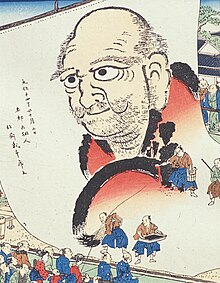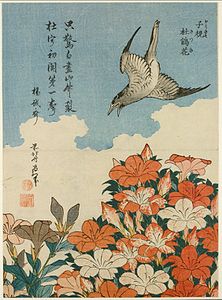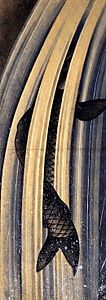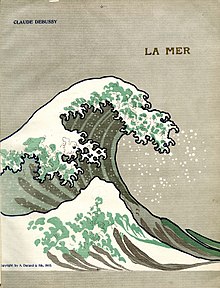Describe the Variety of Art by Hokusai What Types of Subjects Did Da Vinci Paint
| Hokusai | |
|---|---|
| 北斎 | |
 Self-portrait at the historic period of eighty-three | |
| Born | Tokitarō supposedly (1760-10-31)31 October 1760 Edo, Japan |
| Died | 10 May 1849(1849-05-ten) (aged 88) Edo, Japan |
| Known for | Ukiyo-e painting, manga and woodblock printing |
| Notable work | The Great Wave off Kanagawa Fine Wind, Clear Morning |
Katsushika Hokusai ( 葛飾 北斎 , c. 31 October 1760 – 10 May 1849), known simply equally Hokusai, was a Japanese artist, ukiyo-e painter and printmaker of the Edo period.[one] Hokusai is best known for the woodblock print series Thirty-Half-dozen Views of Mount Fuji which includes the internationally iconic impress The Great Moving ridge off Kanagawa.
Hokusai created the monumental Xxx-Half dozen Views of Mount Fuji both as a response to a domestic travel boom in Japan and equally part of a personal obsession with Mountain Fuji.[2] It was this series, specifically The Great Wave off Kanagawa and Fine Current of air, Clear Forenoon, that secured his fame both in Nihon and overseas. While Hokusai'south work prior to this serial is certainly important, information technology was not until this serial that he gained broad recognition.[3]
Hokusai'southward work transformed the ukiyo-e artform from a style of portraiture largely focused on courtesans and actors into a much broader style of art that focused on landscapes, plants, and animals. Hokusai worked in diverse fields besides woodblock prints, such as painting and producing designs for book illustrations, including his own educational Hokusai Manga, which consists of thousands of images of every subject area imaginable over fifteen volumes. Starting equally a young child, he continued working and improving his manner until his death, aged 88. In a long and successful career, he produced over 30,000 paintings, sketches, woodblock prints, and images for picture books in total. Innovative in his compositions and infrequent in his drawing technique, Hokusai is considered one of the greatest masters in the history of art.
Early life [edit]


Fireworks in the Cool of Evening at Ryogoku Bridge in Edo, print, c. 1788–89
Hokusai's appointment of birth is unclear, simply is often stated every bit the 23rd day of the ninth month of the tenth yr of the Hōreki era (in the old calendar, or 31 October 1760) to an artisan family, in the Katsushika district of Edo, the capital of the ruling Tokugawa shogunate.[4] His childhood name was Tokitarō.[5] It is believed his father was Nakajima Ise, a mirror-maker for the shōgun.[5] His male parent never made Hokusai an heir, and so it is possible that his mother was a concubine.[4] Hokusai began painting around the age of six, maybe learning from his begetter, whose work included the painting of designs effectually mirrors.[4]
Hokusai was known past at least thirty names during his lifetime. While the employ of multiple names was a common do of Japanese artists of the time, his number of pseudonyms exceeds that of whatever other major Japanese artist. His name changes are so frequent, and so often related to changes in his artistic production and style, that they are used for breaking his life up into periods.[four]
At the historic period of 12, his father sent him to work in a bookshop and lending library, a popular institution in Japanese cities, where reading books made from woodcut blocks was a popular amusement of the centre and upper classes.[half dozen] At 14, he worked as an apprentice to a woodcarver, until the age of xviii, when he entered the studio of Katsukawa Shunshō. Shunshō was an creative person of ukiyo-e, a style of woodblock prints and paintings that Hokusai would master, and head of the so-called Katsukawa schoolhouse.[five] Ukiyo-east, equally practised by artists like Shunshō, focused on images of the courtesans (bijin-ga) and kabuki actors (yakusha-e) who were popular in Japan's cities at the fourth dimension.[7]
Afterwards a twelvemonth, Hokusai'south proper name changed for the first time, when he was dubbed Shunrō by his primary. It was under this proper name that he published his first prints, a serial of pictures of kabuki actors published in 1779. During the decade he worked in Shunshō's studio, Hokusai was married to his first wife, about whom very little is known except that she died in the early on 1790s. He married again in 1797, although this second wife as well died afterwards a short fourth dimension. He fathered two sons and three daughters with these 2 wives, and his youngest daughter Ei, as well known as Ōi, eventually became an artist and his banana.[seven] [8] Fireworks in the Cool of Evening at Ryogoku Bridge in Edo (c. 1788–89) dates from this menses of Hokusai's life.[9]
Upon the death of Shunshō in 1793, Hokusai began exploring other styles of art, including European styles he was exposed to through French and Dutch copper engravings he was able to learn.[7] He was soon expelled from the Katsukawa school by Shunkō, the chief disciple of Shunshō, possibly due to his studies at the rival Kanō school. This result was, in his own words, inspirational: "What really motivated the evolution of my artistic style was the embarrassment I suffered at Shunkō's hands."[10]
Hokusai also changed the subjects of his works, moving away from the images of courtesans and actors that were the traditional subjects of ukiyo-e. Instead, his work became focused on landscapes and images of the daily life of Japanese people from a variety of social levels. This modify of subject was a breakthrough in ukiyo-e and in Hokusai'southward career.[7]
Middle period [edit]


Contemporary print of Hokusai painting the Great Daruma in 1817


The next menstruum saw Hokusai's association with the Tawaraya Schoolhouse and the adoption of the name "Tawaraya Sōri". He produced many privately commissioned prints for special occasions (surimono), and illustrations for books of humorous poems (kyōka ehon) during this time. In 1798, Hokusai passed his proper noun on to a pupil and fix out as an independent creative person, free from ties to a school for the showtime fourth dimension, adopting the name Hokusai Tomisa.
Past 1800, Hokusai was further developing his use of ukiyo-e for purposes other than portraiture. He had also adopted the name he would most widely be known by, Katsushika Hokusai, the former name referring to the part of Edo where he was born, the latter pregnant 'northward studio', in honour of the North Star, symbol of a deity of import in his religion of Nichiren Buddhism.[11] That year, he published two collections of landscapes, Famous Sights of the Eastern Capital and Eight Views of Edo (modern Tokyo). He also began to attract students of his own, eventually teaching l pupils over the grade of his life.[7]
He became increasingly famous over the next decade, both due to his artwork and his talent for self-promotion. During an Edo festival in 1804, he created an enormous portrait of the Buddhist prelate Daruma, said to be 200 square meters, using a broom and buckets full of ink.[12] Another story places him in the court of the shōgun Tokugawa Ienari, invited there to compete with some other artist who practised more traditional brushstroke painting. Hokusai'due south painted blue curve on newspaper, and so chased a chicken whose feet had been dipped in red paint across the paradigm. He described the painting to the shōgun as a landscape showing the Tatsuta River with red maple leaves floating in it, winning the competition.[13]
Between 1804 and 1815 saw Hokusai collaborate with the popular novelist Takizawa Bakin on a series of illustrated books. Especially popular was the fantasy novel Chinsetsu Yumiharizuki (Foreign Tales of the Crescent Moon, 1807-1811) with Minamoto no Tametomo as the main grapheme, and Hokusai gained fame with his creative and powerful illustrations, merely the collaboration ended afterward thirteen works. At that place are diverse theories every bit to why they dissolved their cooperation, such as discordant personalities and conflicting opinions on how to draw illustrations.[14] [xv] Hokusai also created several albums of erotic fine art (shunga). His most famous image in this genre is The Dream of the Fisherman's Married woman, which depicts a immature woman entwined sexually with a pair of octopuses, from Kinoe no Komatsu, a three-volume volume of shunga from 1814.[16]
Hokusai paid close attention to the production of his work. In letters during his involvement with Toshisen Ehon, a Japanese edition of an anthology of Chinese poetry, Hokusai wrote to the publisher that the blockcutter Egawa Tomekichi, with whom Hokusai had previously worked and whom he respected, had strayed from Hokusai's style in the cutting of sure heads. He also wrote directly to some other blockcutter involved in the project, Sugita Kinsuke, stating that he disliked the Utagawa school way in which Kinsuke had cut the figure'south eyes and noses and that amendments were needed for the final prints to be true to his way. In his letter of the alphabet, Hokusai included examples of both his mode of illustrating optics and noses and the Utagawa school style.[17]
In 1811, at the historic period of 51, Hokusai changed his proper name to Taito and entered the menses in which he created the Hokusai Manga and diverse etehon, or fine art manuals.[5] These manuals outset in 1812 with Quick Lessons in Simplified Drawing, were intended as a user-friendly way to make money and attract more than students. The commencement volume of Manga (significant random drawings) was published in 1814 and was an immediate success.[xviii] By 1820, he had produced twelve volumes (with 3 more published posthumously) which include thousands of drawings of objects, plants, animals, religious figures, and everyday people, often with humorous overtones.[19]
On 5 October 1817, he painted the Great Daruma outside the Hongan-ji Nagoya Betsuin in Nagoya. This portrait in ink on paper measured 18 × x.8 metres, and the event drew huge crowds. The feat was recounted in a popular song and he received the name "Darusen " or "Daruma Principal"[20] [21] Although the original was destroyed in 1945, Hokusai'southward promotional handbills from that time survived and are preserved at the Nagoya Metropolis Museum.
In 1820, Hokusai changed his name yet again, this fourth dimension to "Iitsu," a change which marked the beginning of a period in which he secured fame every bit an artist throughout Japan. His most celebrated work, Thirty-six Views of Mount Fuji, including the famous Great Wave off Kanagawa and Red Fuji was produced in the early 1830s. The results of Hokusai's perspectival studies in Manga can be seen hither in The Great Wave where he uses what would have been seen as a western perspective to correspond depth and volume.[22] It proved so pop that 10 more prints were subsequently added to the series. Among the other popular serial of prints he made during this time are A Tour of the Waterfalls of the Provinces, Oceans of Wisdom and Unusual Views of Celebrated Bridges in the Provinces.[23] He also began producing a number of detailed individual images of flowers and birds (kachō-e), including the extraordinarily detailed Poppies and Flock of Chickens.[24]
Afterwards life [edit]
The adjacent menses, commencement in 1834, saw Hokusai working nether the proper name "Gakyō Rōjin" ( 画狂老人 ; "The Old Man Mad About Art").[25] Information technology was at this time that he produced I Hundred Views of Mount Fuji, some other significant series,[26] generally considered "the masterpiece among his mural pic books".[10]
In the colophon to this piece of work, Hokusai writes:
From the age of six, I had a passion for copying the form of things and since the age of fifty I have published many drawings, nevertheless of all I drew by my seventieth year there is nothing worth taking into account. At seventy-three years I partly understood the structure of animals, birds, insects and fishes, and the life of grasses and plants. And so, at eighty-six I shall progress further; at 90 I shall even farther penetrate their secret meaning, and past one hundred I shall perhaps truly have reached the level of the marvellous and divine. When I am one hundred and ten, each dot, each line volition possess a life of its own.[27]
In 1839, a burn down destroyed Hokusai's studio and much of his work. By this time, his career was showtime to fade as younger artists such equally Andō Hiroshige became increasingly popular. At the age of 83, Hokusai traveled to Obuse in Shinano Province (now Nagano Prefecture) at the invitation of a wealthy farmer, Takai Kozan where he stayed for several years.[28] During his fourth dimension in Obuse, he created several masterpieces, included the Masculine Wave and the Feminine Wave.[28] Betwixt 1842 and 1843, in what he described as "daily exorcisms" (nisshin joma), Hokusai painted Chinese lions (shishi) every morning in ink on paper as a talisman against misfortune.[29] [30]
Hokusai connected working almost until the cease, painting The Dragon of Fume Escaping from Mt Fuji [31] and Tiger in the Snow in early 1849.[32]
Constantly seeking to produce amend work, he apparently exclaimed on his deathbed, "If but Heaven will give me just another ten years ... Just another five more than years, and so I could become a real painter." He died on x May 1849[33] and was cached at the Seikyō-ji in Tokyo (Taito Ward).[five] A haiku he composed before long before his death reads: "Though as a ghost, I shall lightly tread, the summer fields."[32]
-

Dragon on the Higashimachi Festival Float, Obuse, 1844
-

Feminine Wave, painted while living in Obuse, 1845
-

The Dragon of Smoke Escaping From Mount Fuji, painting, 1849
Selected works [edit]
-

-

Cuckoo and Azaleas, 1834
from the Small-scale Flower series -

Egrets from Quick Lessons in Simplified Drawing
-

Carp Leaping up a Cascade
-

-

-

Tenma Bridge in Setsu Province,
from Rare Views of Famous Japanese Bridges -

-

Influences on art and culture [edit]

Hokusai had achievements in various fields as an artist. He fabricated designs for book illustrations and woodblock prints, sketches, and painting for over 70 years.[34] Hokusai was an early experimenter with western linear perspective amidst Japanese artists.[35] Hokusai himself was influenced by Sesshū Tōyō and other styles of Chinese painting.[36] His influences stretched across the globe to his western contemporaries in nineteenth-century Europe with Japonism, which started with a craze for collecting Japanese art, peculiarly ukiyo-e, of which some of the showtime samples were to be seen in Paris, when in about 1856, the French artist Félix Bracquemond first came across a copy of the sketchbook Hokusai Manga at the workshop of his printer.[ citation needed ]
He influenced the Impressionism motility, with themes echoing his piece of work appearing in the work of Claude Monet and Pierre-Auguste Renoir, as well as Fine art Nouveau, or Jugendstil in Germany. Many European artists collected his woodcuts such every bit Degas, Gauguin, Klimt, Franz Marc, August Macke, Manet, and van Gogh.[37] Degas said of him, "Hokusai is not just 1 artist among others in the Floating Earth. He is an island, a continent, a whole world in himself."[38] Hermann Obrist's whiplash motif, or Peitschenhieb, which came to exemplify the new motility, is visibly influenced by Hokusai'southward piece of work.
Even subsequently his death, exhibitions of his artworks keep to abound. In 2005, Tokyo National Museum held a Hokusai exhibition which had the largest number of visitors of whatsoever exhibit at that place that yr.[39] Several paintings from the Tokyo exhibition were also exhibited in the United Kingdom. The British Museum held the starting time exhibition of Hokusai's later year artworks including 'The Great Wave' in 2017.[twoscore]
Hokusai inspired the Hugo Award–winning short story by science fiction author Roger Zelazny, "24 Views of Mt. Fuji, by Hokusai", in which the protagonist tours the surface area surrounding Mount Fuji, stopping at locations painted by Hokusai. A 2011 book on mindfulness closes with the verse form "Hokusai Says" by Roger Keyes, preceded with the caption that "[south]ometimes poetry captures the soul of an idea meliorate than anything else."[41]
In the 1985 Encyclopaedia Britannica, Richard Lane characterizes Hokusai as "since the later 19th century [having] impressed Western artists, critics and art lovers alike, more, possibly, than any other single Asian artist".[42]
'Store Selling Picture Books and Ukiyo-due east' by Hokusai shows how ukiyo-e during the time was actually sold; it shows how these prints were sold at local shops, and ordinary people could buy ukiyo-e. Unusually in this image, Hokusai used a hand-colored approach instead of using several separated woodblocks.[43]
His youngest daughter Ei has her own manga and motion-picture show chosen Miss Hokusai.[44]
A biographical film about the painter was released in Japan on May 28, 2021.[45] It was premiered at the 33rd Tokyo International Pic Festival[46] and originally scheduled to release in May 2020,[45] simply got delayed due to the COVID-19 pandemic.
Notes [edit]
- ^ Nussbaum, Louis Frédéric. (2005). "Hokusai" in Nippon Encyclopedia, p. 345.
- ^ Smith[ page needed ]
- ^ Kleiner, Fred S. and Christin J. Mamiya, (2009). Gardner'south Fine art Through the Ages: Non-Western Perspectives, p. 115.
- ^ a b c d Weston, p. 116
- ^ a b c d e Nagata[ page needed ]
- ^ Weston, pp. 116–117
- ^ a b c d due east Weston, p. 117
- ^ "葛飾, 応為 カツシカ, オウイ" (in Japanese). CiNii. Retrieved 22 May 2017.
- ^ Calza (2003), p. 426
- ^ a b Nagata, Seiji. Hokusai: Genius of the Japanese Ukiyo-e. Kodansha, Tokyo, 1999.[ page needed ]
- ^ The name "Hokusai" (北斎 "North Studio") is an abbreviation of "Hokushinsai" (北辰際 "N Star Studio"). In Nichiren Buddhism the North Star is revered as a deity known as Myōken.
- ^ Calza (2003), p. 128
- ^ Weston, pp. 117–118
- ^ 日美ブログ 第86回 深川・両国・九段へ 北斎と馬琴の面影を探す旅. NHK. February 17, 2019
- ^ 曲亭馬琴と葛飾北斎 Hokusai Museum.
- ^ Calza (2003), p. 455
- ^ Tinios, Ellis (June 2015). "Hokusai and his Blockcutters". Print Quarterly. XXXII (two): 186–191.
- ^ Hillier, Jack R. (1980). The Fine art of Hokusai in Book Illustration. London: Sotheby Parke Bernet; Berkeley, Calif.: Academy of California Press. p. 107
- ^ Weston, p. 118
- ^ A shortened course of Daruma Sensei.
- ^ Calza (2003), p. 192
- ^ Screech, Timon (2012). "Hokusai's Lines of Sight". Mechademia. 7: 107. doi:x.1353/mec.2012.0009. JSTOR 41601844. S2CID 119865798.
- ^ Weston, pp. 118–119
- ^ Weston, p. 119
- ^ Hokusai Heaven retrieved 27 March 2009 Archived three September 2009 at the Wayback Car
- ^ "Fugaku hyakkei (1 Hundred Views of Mount Fuji)". Museum of Fine Arts, Boston. December 21, 2018. Retrieved January 22, 2019.
- ^ Calza, Gian Carlo. "Hokusau: A Universe" in Hokusai, p. seven. Phaidon
- ^ a b "Welcome to the World of Hokusai, an "Former Man Mad About Painting"!". Hokusai Kan. Hokusai Museum. 7 March 2018. Retrieved 16 May 2019.
- ^ Machotka, Ewa (2009). Visual Genesis of Japanese National Identity: Hokusai's Hyakunin Isshu. Peter Lang. ISBN9789052014821.
- ^ "Fine Japanese Art, lot 252". Bonhams. 2008. Retrieved v Nov 2020.
- ^ "The Dragon of Smoke Escaping From Mount Fuji, 1849 by Hokusai". KatsushikaHokusai.com . Retrieved 2 November 2020.
- ^ a b Tsuji Nobou in Calza (2003), p. 72
- ^ (18th day of the 4th month of the 2nd twelvemonth of the Kaei era past the old calendar)
- ^ Finley, Ballad (1 Jan 1998). Fine art of Nippon: Woods-block Color Prints. Lerner Publications. ISBN9780822520771.
- ^ "Paintings equally architectural space:"Guided Tours" past Cezanne and Hokusai". 2008.
- ^ Daniel Atkison and Leslie Stewart. "Life and Art of Katsushika Hokusai" in From the Floating World: Part Two: Japanese Relief Prints, catalogue of an exhibition produced by California State University, Chico. Retrieved 9 July 2007; Archived 8 November 2002 at the Wayback Machine
- ^ Rhodes, David (November 2011). "Hokusai Retrospective". The Brooklyn Rail.
- ^ "How, subsequently decease, Hokusai changed art history". Phaidon. x May 2017. Retrieved 6 Nov 2020.
- ^ Brown, Kendall H. (13 August 2007). "Hokusai and His Age: Ukiyo-e Painting, Printmaking and Book Illustration in Late Edo Japan (review)". The Journal of Japanese Studies. 33 (ii): 521–525. doi:10.1353/jjs.2007.0048. ISSN 1549-4721. S2CID 143267375.
- ^ Carelli, Francesco (2018). "Hokusai: beyond the Nifty Moving ridge". London Periodical of Main Care. 10 (four): 128–129. doi:x.1080/17571472.2018.1486504. PMC6074688. PMID 30083250.
- ^ Mark Williams and Danny Penman (2011). Mindfulness: An 8-Calendar week Plan for Finding Peace in a Frantic Earth, pp. 249, 250–251. The poem is besides at Hokusai Says – Gratefulness.org.
- ^ Lane, Richard (1985). "Hokusai", Encyclopædia Britannica, five. five, p. 973.
- ^ Finley, Carol (Jan 1998). Art of Japan: Wood-cake Colour Prints. ISBN9780822520771.
- ^ Hoeij, Boyd van (xxx October 2015). "'Miss Hokusai' ('Sarusuberi: Misu Hokusai'): Movie Review". The Hollywood Reporter . Retrieved 7 June 2021.
- ^ a b "HOKUSAI IN CINEMAS MAY 28". hokusai2020.com . Retrieved 7 June 2021.
- ^ Blair, Patrick Brzeski,Gavin J.; Brzeski, Patrick; Blair, Gavin J. (2 Nov 2020). "Tokyo Film Festival Opens With Low-cal COVID-19 Restrictions, Support from Christopher Nolan". The Hollywood Reporter . Retrieved 7 June 2021.
References [edit]
- Calza, Gian Carlo (2003). Hokusai. Phaidon. ISBN0714844578.
- Lane, Richard (1978). Images from the Floating Earth: The Japanese Impress. Oxford: Oxford University Press. ISBN 978-0-19-211447-1; OCLC 5246796.
- Nagata, Seiji (1995). Hokusai: Genius of the Japanese Ukiyo-east. Tokyo: Kodansha International.
- Ray, Deborah Kogan (2001). Hokusai: The Human Who Painted a Mountain. New York: Frances Foster Books. ISBN 0-374-33263-0.
- Smith, Henry D. Ii (1988). Hokusai: One Hundred Views of Mt. Fuji. New York: George Braziller, Inc., Publishers. ISBN 0-8076-1195-vi.
- Weston, Mark (1999). Giants of Japan: The Lives of Japan's Most Influential Men and Women. New York: Kodansha International. ISBN ane-56836-286-2.
Further reading [edit]
General biography [edit]
- Bowie, Theodore (1964). The Drawings of Hokusai. Indiana University Press, Bloomington.
- Forrer, Matthi (1988). Hokusai Rizzoli, New York. ISBN 0-8478-0989-7.
- Forrer, Matthi; van Gulik, Willem R., and Kaempfer, Heinz K. (1982). Hokusai and His School: Paintings, Drawings and Illustrated Books. Frans Halsmuseum, Haarlem. ISBN 90-70216-02-7
- Hillier, Jack (1955). Hokusai: Paintings, Drawings and Woodcuts. Phaidon, London.
- Hillier, Jack (1980). Art of Hokusai in Book Illustration. Sotheby Publications, London. ISBN 0-520-04137-two.
- Lane, Richard (1989). Hokusai: Life and Work. Due east.P. Dutton. ISBN 0-525-24455-seven.
- van Rappard-Boon, Charlotte (1982). Hokusai and his School: Japanese Prints c. 1800–1840 (Catalogue of the Collection of Japanese Prints, Rijksmuseum, Role III). Rijksmuseum, Amsterdam.
Specific works of art [edit]
For readers who desire more data on specific works of fine art by Hokusai, these particular works are recommended.
- Hillier, Jack, and Dickens, F.W. (1960). Fugaku Hiyaku-kei (One Hundred Views of Fuji past Hokusai). Frederick, New York.
- Kondo, Ichitaro (1966). Trans. Terry, Charles S. The Thirty-six Views of Mountain Fuji by Hokusai. Eastward-West Center, Honolulu.
- Michener, James A. (1958). The Hokusai Sketch-Books: Selections from the 'Manga' . Charles E. Tuttle, Rutland.
- Morse, Peter (1989). Hokusai: One Hundred Poets. George Braziller, New York. ISBN 0-8076-1213-8.
- Narazaki, Muneshige (1968). Trans. Bester, John. Masterworks of Ukiyo-East: Hokusai – The Xxx-Half dozen Views of Mt. Fuji. Kodansha, Tokyo.
Art monographs [edit]
Monographs dedicated to Hokusai art works:
- Goncourt, Edmond de (2014). Essential Hokusai. Bournemouth, Parkstone International. ISBN 978-1-78310-128-3.
- Goncourt, Edmond de (2014). Hokusai Mega Foursquare. Bournemouth, Parkstone International. ISBN 978-one-78310-566-3.
External links [edit]
| | Wikiquote has quotations related to: Hokusai |
- Hokusai-Museum in Obuse, Japan
- Hokusai website
- Works by Hokusai at Faded Page (Canada)
Prints [edit]
- Hokusai complete works
- Ukiyo-e Prints by Katsushika Hokusai
- Hokusai prints at the Museum of Fine Arts, Boston
- Hokusai's works at Tokyo Digital Museum
- Hokusai's works at the University of Michigan Museum of Art
Biographies [edit]
- Biography of Katsushika Hokusai, British Museum
0 Response to "Describe the Variety of Art by Hokusai What Types of Subjects Did Da Vinci Paint"
Post a Comment